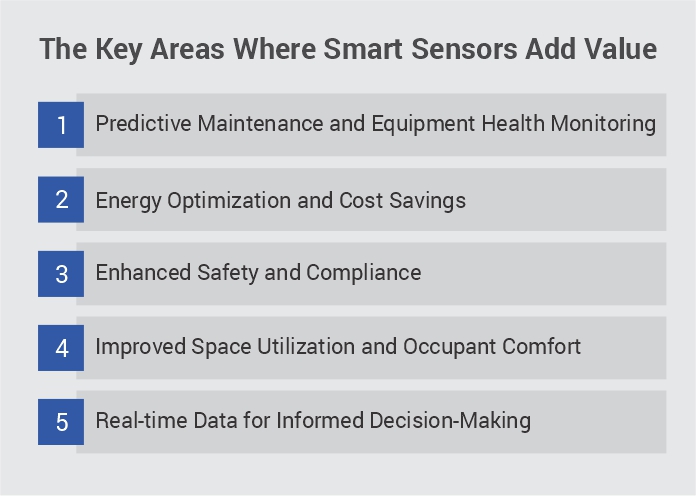In today’s rapidly evolving landscape, Facility Management Companies in India are increasingly adopting advanced technologies to streamline operations, reduce costs, and deliver smarter, safer, and more sustainable environments. At the forefront of this transformation are smart sensors — small devices with the power to make a big impact. From real-time monitoring to predictive maintenance, smart sensors are revolutionizing facilities and management across sectors, including commercial buildings, manufacturing plants, healthcare institutions, and corporate campuses.
This blog explores the key ways in which smart sensors are shaping the future of Facility Management Solutions, offering a comprehensive view of their role in enhancing efficiency, safety, and sustainability.
What Are Smart Sensors?
Smart sensors are devices equipped with microprocessors and connectivity capabilities that gather, process, and transmit data to centralized systems. Unlike traditional sensors that only record specific parameters, smart sensors are capable of analyzing inputs such as temperature, humidity, motion, pressure, occupancy, and even air quality, sending actionable insights in real time.
When integrated into a broader facility management service provider platform, these sensors enable automation, analytics, and decision-making capabilities that are transforming maintenance and operations in India.
The Key Areas Where Smart Sensors Add Value

1. Predictive Maintenance and Equipment Health Monitoring
Gone are the days of reactive maintenance, where teams would fix systems only after a breakdown. Smart sensors help shift from a reactive to a predictive model. These sensors monitor equipment parameters such as vibration, heat levels, and usage patterns to predict failures before they occur.
By enabling predictive maintenance, facility management companies in India can reduce equipment downtime, extend asset life, and cut maintenance costs by up to 40%. This predictive capability is especially valuable in industries with high-value assets like HVAC systems, elevators, and power generators.
2. Energy Optimization and Cost Savings
Energy consumption remains one of the highest operational costs in facility management. Smart sensors play a critical role in reducing this burden. Occupancy sensors, temperature sensors, and lighting sensors enable dynamic control of lighting, air conditioning, and heating systems based on actual usage rather than fixed schedules.
By automating energy-intensive systems, smart sensors empower facility management solutions to optimize energy use, reduce wastage, and support sustainability goals. Over time, this also contributes to substantial cost savings and reduced carbon footprints.
3. Enhanced Safety and Compliance
Safety is paramount in facility management, especially in industrial settings. Smart sensors enhance workplace safety by detecting gas leaks, fire hazards, chemical exposure, and unauthorized access. They also provide real-time alerts that help facility teams act swiftly to prevent accidents.
Moreover, in sectors governed by strict regulations, such as pharmaceuticals or food processing, smart sensors aid compliance by continuously monitoring conditions like humidity, temperature, and air quality, thereby ensuring adherence to prescribed standards.
4. Improved Space Utilization and Occupant Comfort
Space is a valuable resource, and smart occupancy sensors can help optimize its use. These sensors track room usage patterns and occupancy levels to help facility management service providers make data-driven decisions about workspace allocation, conference room scheduling, and building layout redesigns.
At the same time, environmental sensors ensure optimal comfort levels by adjusting lighting, air conditioning, and ventilation according to the number of occupants and prevailing conditions. This creates a more comfortable and productive environment for occupants - a major plus in commercial and office facilities.
5. Real-time Data for Informed Decision-Making
One of the most transformative aspects of smart sensors is their ability to feed real-time data into centralized dashboards. This enables facility managers to monitor multiple parameters - from energy use to occupancy - across several locations simultaneously.
Through integrated platforms and IoT dashboards, facility management companies in India can take a proactive approach to operations. Managers can identify inefficiencies, forecast future needs, benchmark performance, and make quicker decisions based on accurate data.
Case in Point: Smart Sensors in Industrial Facilities:
In the context of maintenance and operations in India, industrial facilities benefit significantly from smart sensor technology. For instance:
- Manufacturing plants can use vibration sensors to monitor motors and machinery.
- Oil and gas installations can deploy gas and temperature sensors to prevent hazards.
- Pharmaceutical units can maintain stringent climate control using environmental sensors.
- Warehouses benefit from motion detectors and asset-tracking sensors for better logistics and security.
These examples demonstrate how facility management service providers can enhance performance and safety while minimizing disruptions in highly demanding environments.
Integration with Building Management Systems (BMS)
Smart sensors don't function in isolation. When integrated with Building Management Systems (BMS), they create a powerful ecosystem that automates control over HVAC, lighting, access control, fire systems, and more.
This integration allows facility management companies in India to provide holistic facility management solutions that go beyond basic upkeep. The synergy between sensors and BMS leads to streamlined workflows, reduced manual intervention, and better resource allocation.
Smart Sensors and ESG Goals
With environmental and social governance (ESG) gaining prominence, facility management companies in India are under increasing pressure to align their operations with sustainability goals. Smart sensors help companies:
- Monitor and reduce energy and water usage
- Track waste levels and manage recycling efficiently
- Maintain indoor air quality and reduce emissions
- Support health and safety standards
By helping businesses achieve these goals, smart sensors position facilities and management as active contributors to a greener and more responsible future.
Challenges and Considerations
Despite their advantages, smart sensors also present certain challenges:
- Initial Investment: Although costs are declining, installing smart sensors and IoT infrastructure involves upfront investment.
- Data Security: As these devices are network-connected, they are vulnerable to cyber threats if not protected.
- Interoperability: Ensuring that sensors from different vendors communicate seamlessly within a unified platform requires careful planning.
- Skilled Workforce: Facility managers and technicians must be trained to interpret sensor data and manage automated systems effectively.
To address these issues, facility management companies in India are partnering with technology vendors and investing in employee training to upskill their teams.
The Future: AI and Machine Learning Integration
As sensor technology matures, integration with artificial intelligence (AI) and machine learning (ML) will take facility management solutions to the next level. Predictive analytics, anomaly detection, automated decision-making, and performance optimization will become more advanced and accurate.
In the future, we can expect:
- AI-powered systems that suggest maintenance actions before faults occur
- Adaptive buildings that self-regulate based on occupancy and weather
- Advanced reporting tools for ESG compliance and resource planning
- Seamless integration with mobile apps for real-time control and alerts
These advancements will not only transform how facilities operate but also how facility teams are structured and managed.
Conclusion: A Smart Step Forward
Incorporating smart sensors into facility operations is no longer a futuristic concept — it's a present-day necessity. They serve as the eyes and ears of modern facility management service providers, enabling data-driven decisions, boosting efficiency, and ensuring compliance and occupant safety.
For facility management companies in India, embracing smart sensor technology offers a significant competitive edge. From manufacturing units to corporate parks, the ability to proactively monitor and manage assets translates to cost savings, increased client satisfaction, and sustainable operations.
As India’s infrastructure grows smarter, smart sensors will be integral to every well-managed facility — shaping the very definition of facilities and management for years to come.
Also read: Impact of Poor Facility Management on Business Performance

